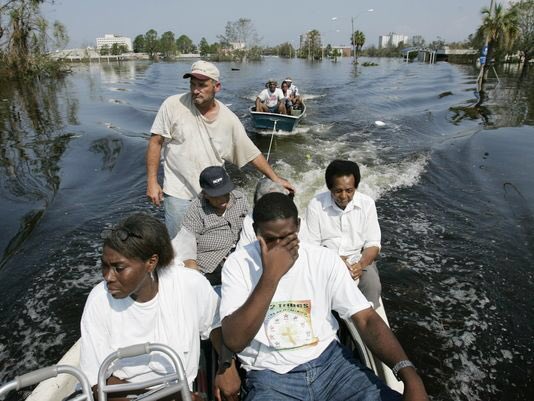
On Sunday, as news of rising waters and ongoing devastation in Texas following Hurricane Harvey continued to make the rounds on social media, one image started to stand out. A line of trucks, all of which were towing a boat, were headed to Texas. The Cajun Navy had mobilized and were on their way to do their part in the ongoing rescue effort.
The boats in question aren’t your typical naval boats and the Cajun Navy isn’t your typical navy. They are good-hearted folks from Louisiana who strike out in their fishing boats, their hunting boats, their shallow draft duck hunting boats, their airboats and their canoes and kayaks to rescue those in need of rescuing. The groups origins trace back to the aftermath of Hurricane Katrina, but they became more of a well-known, officially branded organization following Louisiana’s “Great Flood of 2016.”
According to their group’s Facebook page, the Cajun Navy’s mission statement says “We the people of Louisiana refuse to stand by and wait for help in the wake of disasters in our State. We rise up and unite and rescue our neighbors!”
Here is what you need to know about the Cajun Navy.
1. The Navy Initially Took Shape in the Wake of Hurricane Katrina
After Hurricane Katrina hit Louisiana in 2005 the governor at the time, Kathleen Blanco, and other government officials called upon citizens to assist with the numerous rescue efforts taking place across the state. The initial response was roughly 23 vessels.
“To me, going in and pulling people out of the water was just the right thing to do. It was our responsibility as citizens, Louisianans,” said Sara Roberts, who was part of the original group.
More people would join in the following years and the Navy would routinely activate when they felt their help was needed. By the time Louisiana was overtaken by state-wide flooding in 2016, the Cajun Navy claimed to have over a thousand members.
2. The Navy Sprung Into Action Before FEMA Did in 2016
In 2016 Louisiana was hit with massive, state-wide flooding. FEMA, the Federal Emergency Management Agency, was slow to respond. The people of Louisiana were already skeptical of the government agency due largely to FEMA’s lackluster response to Hurricane Katrina. While FEMA was still organizing their rescue efforts, the Cajun Navy had already been deployed.
“People just came out in full force. And not just Cajuns: People from Mississippi, people from up north,” said Lafayette-area resident Shawn Boudreaux. Boudreaux had been one of the people coordinating the Navy’s rescue efforts.
The Cajun Navy isn’t comprised solely of people from Louisiana and also includes boaters and volunteers from neighboring Mississippi.
3. The Cajun Navy Uses Social Media to Mobilize and Communicate
Part of the reason why the Cajun Navy was so effective in 2016 was because of their skilled use of social media. Over 70,000 people like their Facebook page, which is helpful in the wake of disasters as it makes it easier to get the word out for help. The group also uses Twitter to help communicate and recruit volunteers. Since Sunday morning, stranded residents in Texas have been reaching out to the Navy via Twitter, using the #CajunNavy hashtag.
In the field and in action, the Cajun Navy uses Zello, an app on their phones. The app performs a similar function as a CB radio does and acts as a broad band radio frequency or a walkie-talkie. If you type in “Texas search and rescue” you can then narrow your search to determine what search and rescue operations are going on in a particular area.
4. In 2016, a Louisiana Lawmaker Announced a Plan to Regulate the Navy
Following the 2016 flood Senator Jonathan Perry, a Republican from the state’s Vermillion-Lafayette area, announced a plan to put together legislation that would require members of the Cajun Navy to undergo training, obtain certificates and pay a permit fee. The fee would then allow Navy members to get past state and local law enforcement during rescue operations.
“At the end of the day, there are going to be two things that are going to be the hurdle when you approach it from the state’s standpoint,” Perry said. “Liability is going to be number one for them. They don’t want the liability of someone going out to rescue someone and then not being able to find them (the rescuers) and, secondly, there’s a cost.”
The proposed legislation didn’t make sense to the group’s members.
“How can you regulate people helping people? That doesn’t make sense to me,” said Dustin Clouatre, a Cajun Navy member from St. Amant, Louisiana. There also hasn’t been an official census of the group, so it’s unclear how many people would have to undergo training if the legislation were to pass.
5. The Navy Accepts Donations Ranging From Financial Assistance to Food
As with any volunteer organization, the Cajun Navy’s efforts are bolstered by donations. The group accepts financial donations through their website, but also accept other donations, such as food, drinks and supplies.
While coordinating efforts in 2016, Boudreaux said that people even donated ethanol-free fuel for captains to use to fuel their boats.



